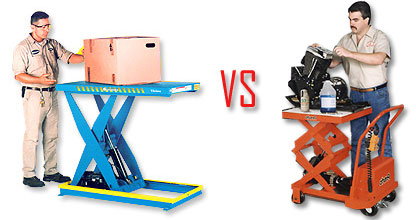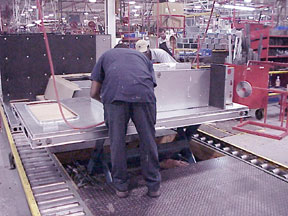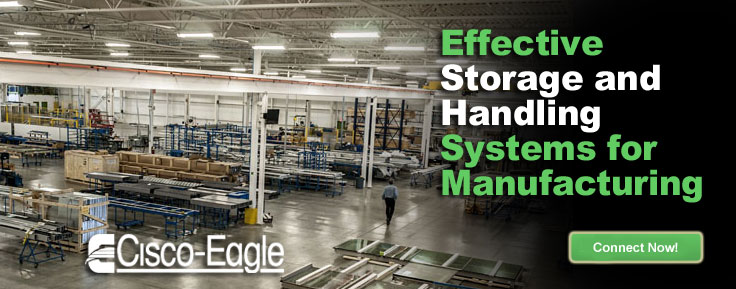Industrial Scissor Lift Tables: Mobile vs. Stationary
What are the critical differences for manufacturing, assembly and order picking?

Mobile lift tables are increasing in popularity in many assembly and repair operations for a number of reasons, but using this flexible material handling device must be approached correctly, and with your eyes open. They provide more flexible use (move them where you want them) in everything from printing or assembly industries to pallet breakdowns in distribution. They’re great for flexible production lines or lean manufacturing lines or work cells where the ability to lift and move something is at a premium – in particular if you need to frequently reconfigure work areas.
Obviously, a lift table you can roll to where you need it is highly desirable, but what does that mobility cost you? And when should you choose stationary lift table over mobile?
Collapsed height makes a difference
 We often see applications where the collapsed height of a lift table is the critical dimension, since it must match a conveyor line or other handling equipment. Portable lift tables trade that low collapsed height for portability. Low profiles can be extremely important. When you mount scissor lifts on wheels, you create several inches of new height that can’t be retracted. The collapsed height factor is so important that many lift manufacturers have specific, low-profile lift table lines that get down to 1.9″ just to ensure they can meet the demand for very low profiles. We have actually installed lifts below the floor level just to reduce their profile, so this can matter quite a lot in many applications.
We often see applications where the collapsed height of a lift table is the critical dimension, since it must match a conveyor line or other handling equipment. Portable lift tables trade that low collapsed height for portability. Low profiles can be extremely important. When you mount scissor lifts on wheels, you create several inches of new height that can’t be retracted. The collapsed height factor is so important that many lift manufacturers have specific, low-profile lift table lines that get down to 1.9″ just to ensure they can meet the demand for very low profiles. We have actually installed lifts below the floor level just to reduce their profile, so this can matter quite a lot in many applications.
Stability is another factor
Mobile lift tables are somewhat less stable than stationary ones. It’s important to center the load on any scissor lift, but that importance is magnified for mobile lifts. Off-center loads will be less stable than they are on fixed-position lifts. If you use a mobile lift, adhere particularly well to the loading protocols and err on the side of caution when loading and unloading it.
Mobile lifts are more expensive than equivalent stationary lifts, but when they’re right, it’s worth it
This is in part because they must be better-built and more carefully engineered. Parts of the structure (such as the base frame) must be load-bearing. The casters and wheels must be correctly specified. When wheels are replaced, they must also be correctly specified for capacity and size.
While stationary lifts aren’t as flexible as mobile lifts, relocating them in case of a line reconfiguration isn’t a monumental task. Most are relatively easy to disconnect and reinstall, although you would not want to do this frequently.
Bottom line
Generally, stationary lifts have higher capacities and a larger range of sizes, power options, and available accessories. To me, it’s a bit like choosing a laptop computer instead of a desktop one. The laptop costs more money, and does a bit less, but does it anywhere you want. That’s key for many operations, and makes the mobile lift an outstanding value for the correct application.

Tags: industrial safety, industrial lift tables, scissor lifts
Scott Stone is Cisco-Eagle's Vice President of Marketing with more than thirty years of experience in material handling, warehousing and industrial operations. His work is published in multiple industry journals an websites on a variety of warehousing topics. He writes about automation, warehousing, safety, manufacturing and other areas of concern for industrial operations and those who operate them.



